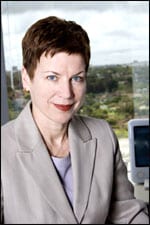 Joseph M. Hogan is focused on one thing — growth. The president and CEO of GE Medical Systems (GEMS of Waukesha, Wis.), who is entering his third year in that role, is a strong proponent for IT proliferation in radiology, advancing minimally invasive surgery, and increasing applications within radiology’s staple technologies, namely in the digital realm.
Joseph M. Hogan is focused on one thing — growth. The president and CEO of GE Medical Systems (GEMS of Waukesha, Wis.), who is entering his third year in that role, is a strong proponent for IT proliferation in radiology, advancing minimally invasive surgery, and increasing applications within radiology’s staple technologies, namely in the digital realm.
Hogan speaks from the seat of president and CEO yet his roles in sales, marketing and product management shine through as he closely details GEMS’ market position and product portfolio. Hogan began his career at General Electric Co. (GE of Fairfield, Conn.) in 1985, advancing through a series of sales, marketing and product management positions at GE Plastics. In 1996, he was promoted to a staff executive role in GE’s corporate offices in Fairfield. In March 1998, Hogan was named president and CEO of GE Fanuc Automation North America, Inc., a global supplier of industrial controls systems in Charlottesville, Va., and a joint venture between GE and FANUC Ltd Japan.
Hogan joined GE Medical Systems in April 2000 as vice president of global ebusiness, a role that was expanded in June 2000 to the role of executive vice president and chief operating officer. Following the succession of then GEMS President Jeffrey Immelt to chairman-elect of GE in November 2000, Hogan was promoted to his current position.
Medical Imaging spoke with Hogan recently about the overall health of the radiology business, areas of growth within the marketplace and the future of radiology reimbursement.
In what technologies should wise radiology and hospital administrators be investing in today?
The obvious answer is any technology that helps hospitals improve patient outcomes while at the same time, keeping costs down and productivity high. We see CT use increasing for cardiac applications, as well as a wise investment for the emergency department. By using eight-slice and 16-slice CT, physicians are able to see things they haven’t been able to before. It is great technology that eliminates unnecessary “exploratory” cardiac catheterizations, while freeing up capacity in cath labs that are “maxed” out. This is a win for radiologists, cardiologists, hospitals, and ultimately, their patients.
Please refer to the November 2002 issue for the complete story. For information on article reprints, contact Martin St. Denis




